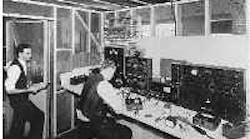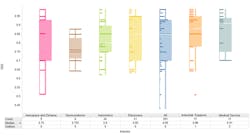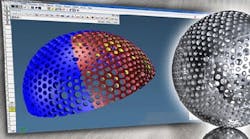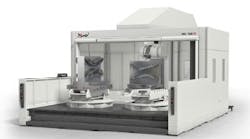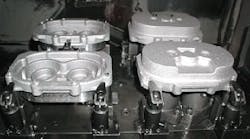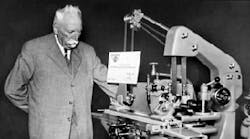Electronic controls changed how companies cut metal.
Allen-Bradley's experimental test laboratory as it looked in September 1937.
Allen-Bradley employees hand-check the resistances of Type E hot-molded carbon composition resistors, about 1936.
A photo from 1970 shows Vicker's CIP/2000 minicomputers, which were incorporated into shop floor products like digitizers and part-program editing services.
In 1965, Vickers (then a part of Cincinnati Milacron) developed the Acramatic IV, the first control in the industry to use surface-mount technology to mount flat pac integrated circuits to circuit boards.
Although innovations in machine design and cutting tool materials and geometries had a major impact on metalcutting, computer control is arguably the most important change to the industry in the later half of the 20th century. With the introduction of the CNC, flexible machining became a reality.
Allen-Bradley: A penchant for electricity
In 1935, a newly designed Allen-Bradley relay was used by Browne & Sharpe in its B-12 milling machine—the first electrically driven machine tool. Allen-Bradley was launched on its path as a world leader in automation and machine controls.
As World War II began, Allen-Bradley was in the midst of an enormous expansion effort that more than doubled the company's plant area by 1948. Much of this growth was the result of the company's reputation for quality, particularly among East Coast machine-tool manufacturers.
The 1940s era was a period of rapid growth and peak production for the company. Allen-Bradley was the recognized leader in the electronics field. The military demand for A-B hot-molded resistors exceeded production capacity and attempts were made to have Allen-Bradley instruct competitors in the manufacture of its resistors. A-B resistors were used in all current electronic devices including walkie-talkies, radar equipment and radios.
In 1946, a Special Machine Department was created to transform the assembly of resistors from a manual process to a more automated system. This department was the forerunner of the Industrial Control Group's Automation Equipment Manufacturing Department.
In spite of this high production, management had some concern because the company had not introduced many major new products since before World War II. As the Milwaukee-based company known for its "Quality Motor Control and Radio Parts" entered the age of electronics and television, the drive for new product development became intense.
During the following years, the company grew rapidly in the development of ferrites, ceramic magnets, and thin-film resistors. Through a series of acquisitions, Allen-Bradley formed its Industrial Computer Group in Highland Heights, Ohio, marketing programmable controllers, intelligent motion-control devices, industrial computers, data communications and acquisition systems and equipment.
GE Fanuc: A uniting of control innovators
In 1955, FANUC was established in Japan by Fujitsu (then Fujitsu Communications) as an experimental project—an in-company venture in automatic controls research. Dr. Seiuemon Inaba, Fujitsu's project leader in automatic controls research, became president of the company and has remained in that position. Within a year of taking command of a seven-man team, Inaba's group produced Japan's first numerical controlled apparatus. Two years later, the group completed Japan's first NC machine tool with Makino Machine Tool Co.
Meanwhile, General Electric in the U.S. had also moved into factory automation. GE provided automation system design and implementation and manufacturing software and hardware for a variety of electric-industrial control equipment, for both its own facilities and for customers worldwide. In 1981, GE combined these automation products and services into a Factory Automation Division, with headquarters in Charlottesville, Va. About the same time, Jack Welch took the reins as CEO at GE.
In 1972, Inaba convinced Fujitsu that his NC division could not be a consistent money maker unless it broke away and faced the realities of the market head on. And so, FANUC Ltd. became an independent company. At this time, General Electric and Fujitsu each produced about 2,000 NC devices a year but by 1986, under the technical and entrepreneurial leadership of Inaba, FANUC had pulled away from GE and all the competition.
Throughout the 1980s, Jack Welch challenged conventional wisdom, relentlessly examining his businesses and reengineering them. One of his tactics included joint ventures and, in 1986, GE and FANUC entered into a joint venture and established a new company—GE Fanuc Automation Corp.—to serve the rapidly growing worldwide market for high-tech factory automation equipment and systems.
Rick Richardson, vice president of GE's Factory Automation Division, and Dr. Inaba said the new venture would improve the competitiveness of both companies in world markets. Richardson said the new company would help General Electric expand its successful and growing five-year-old factory automation business into European and Asian markets.
Vickers Electronic Systems: Changes in name, changes in focus
During its 44-year history, Vickers Electronic Systems (VES) has undergone six name changes— each new name reflecting a significant shift in the company's philosophy, product focus, and/or markets to meet the constantly developing controls market.
VES came into existence in 1954 as the Electrical Engineering Department of Cincinnati Milacron. The operation got off to a good start: Before it was one year old, the Electrical Engineering Department introduced the first electric tracer for machine tools. One year later, this Cincinnati Milacron team developed the industry's first electronic line tracer, which utilized a revolutionary electronic scanner to trace lines on a drawing. If R&D time for the electronic line tracer was short, its employment was not: Some of these tracers were in operation up until a decade ago.
In 1956, the Electrical Engineering Department bought the U.S. license to EMI (Electrical and Music Industries) controls— the most advanced numerical control of the time—and installed them on machine tools for a U.S. Air Force Wright Field program.
To reflect increased focus on electronic controls, electronic gages, and hydraulic valves, in 1957 the Electrical Engineering Department became the Electro Hydraulic and Gaging Division. While operating under this name, the company shipped its first EMI control bringing electrical control to the hand wheel.
In 1960, the fast-growing Cincinnati Milacron changed its name to Cincinnati Milacron Controls Division (CIMTROL). Over the next couple of years, CIMTROL developed its first Thousand Series continuous path controls; Hundred Series positioning controls; and an early programmable controller. In 1965— the same year the division opened a plant in Biggleswade, England, as part of its international expansion plan—CIMTROL also introduced the first control to use surface-mounting manufacturing.
In 1967, the division also began pioneering advancements in computer-controlled fabric cutters and, in 1967, introduced a control and machine that could cut up to 50 pieces of fabric at once.
But CIMTROL also was weaving other alliances. The year it introduced fabric cutters, the division was selected as partner to the U.S. Air Force to advance adaptive control. Developed to monitor torque and deflection, the adaptive control was among the earliest algorithms to optimize feeds and speeds during machining.
One year later, CIMTROL introduced the first digitizer for automating the programming processes on automotive dies. Developed prior to the advent of the microprocessor, the scanner digitized Chevrolet parts surfaces for parts programming.
CIMTROL had discovered the promise of computer technology, and, in 1970, introduced the Cincinnati Information Products (CIP) 2000 mini-computer—a forerunner to today's advanced computer numeric control (CNC) technology.
However, because the CIP 2000 had applications in process industries as well as discrete manufacturing, CIMTROL again changed
its name in 1970, becoming the Process Controls Division. During its seven-year life-span, the Process Controls Division also was responsible for developing the first scanner; offline parts program editor; and the direct numerical control (DNC), an innovation which allowed data to be sent to NC machines before plant-wide local area networks were available. In 1973, the Process Controls Divisions also put its first CRT on the shop floor, with the introduction of its premiere computer numerical control (CNC).
With the division's emerging emphasis on machine-tool controls, the Cincinnati Milacron division again changed its name, in 1977 becoming the Electronic Systems Division. In 1978, the newly renamed division launched its entry into the plastics control market. In 1979, the division also introduced its first robotic control.
Other milestones during the 1980s and 1990s include the 1989 establishment of the division's manufacturing retrofit business and the 1991 establishment of contract manufacturing business.
In 1996, the then-42-year-old Cincinnati Milacron division again changed names, and hands, when purchased by Vickers, Inc.—a subsidiary of Aeroquip-Vickers Inc. Now, as Vickers Electronic Systems (VES), the former Cincinnati Milacron division can market its advanced control technology to all machine-tool manufacturers.
